1. SEDAKAH MOUNT MERAPI - BOYOLALI CENTRAL JAVA
The tradition of the ceremony and procession of Alms of Mount Merapi, by the people around Mount Merapi, especially by the people in Lencoh Village, Selo District, Boyolali Regency, is held once a year to welcome the Javanese New Year 1 Suro.
Alms Gunung or Larung to Mount Merapi has been carried out since ancient times and continues to this day and has even become a special agenda and event for the Selo Boyolali community in being grateful for the blessings of life over the past year and an appeal to God Almighty to get a better life in the future.
The Mountain Alms tradition is also a form of harmonization and respect for the people on the slopes of the Mountain for the safety and fertility of the land they get and they express their gratitude by means of Mount Alms or Larung.
This local wisdom tradition event is the culmination of various series that are held from morning to evening with processions around the village, and at night usually thousands of people crowd Joglo 1 Selo Tourism Area, to take part in the traditional mountain alms ceremony and usually a shadow puppet show is also served. all night.
This local wisdom activity is a form of prayer to God Almighty to ask for the protection and safety of residents living on the slopes of Mount Merapi.
"Traditional rituals of the Selo people are routinely held every year, in the form of alms and offerings of buffalo's head at the top of Mount Merapi,"
At the peak of the Mount Merapi alms ceremony procession, in the evening a buffalo head is thrown in the crater of the peak of Mount Merapi.
Each region will have a way that is local wisdom in respecting nature and respecting the power of God Almighty.
2. TRADITIONAL SERVICE OF ALWAYS SEA - CILACAP - CENTRAL JAVA
Agrarian communities who live in the mountains and inland have the Ruwat Bumi traditional ceremony, the Bumj Alms as a form of gratitude, while the coastal communities also have the Sea Alms traditional ceremony as an expression of gratitude to the Almighty God.
Cilacap as one of the southern coastal communities also holds a sea alms ritual or larung offerings on the south coast.
The Sedekah Laut traditional ceremony is a tradition that has existed since the time of the ancestors and this tradition is not related to any particular creed or belief.
This tradition is an embodiment of the coastal community's gratitude to God Almighty for the abundance of sustenance they receive. Not surprisingly, this activity is always accompanied by chanting prayers to the Almighty.
"It's just that the expression of gratitude for the Javanese, apart from prayer, usually must be in the form of certain objects (offerings),"
In this sea alms procession, as many as 10 Jolen from a number of fishing groups and the Cilacap Regency Government were brought from the district pavilion before being floated into the South Sea.
Jolen comes from the word Ojo Kelalen, which means don't forget, jolen seems to remind people not to forget the Almighty for the sustenance they receive. Alms sea is the embodiment. Jolen usually contains the head of a cow or goat, as well as other umbo rampe.
The tradition of handing over Jolen is still being preserved by the current regent when the procession is held so that this traditional performance remains sustainable and dynamic.
One of the local wisdoms that must be preserved in the beloved Persada earth, INDONESIA.
3. EARTH ALREADY TRADITIONAL SERVICE - CIBUNTU-KUNINGAN VILLAGE, JABAR
As an agrarian society, the people of West Java, especially those in Cibuntu Village, Pasawahan District, Kuningan Regency, West Java, always perform the Sedekah Bumi traditional ceremony as a form of gratitude for the harvest and fortune they have enjoyed. The form of gratitude to Hyang the Almighty is realized by holding a traditional ceremony of alms to the earth.
In this procession, the community usually prepares everything lively, this traditional Sedekah Bumi ceremony presents a variety of village specialties to traditional art entertainment.
The guests of honor were greeted with the traditional art of Ki Lengser, followed by the tetenong dance (a food container made of woven bamboo).
Before the event started, thousands of residents made a procession while carrying a tetenong containing a variety of local village specialties.
Residents walked approximately one kilometer to the event center in the Sidarang field and Cibuntu Village. The men carried the tetenong on their shoulders, while the women walked with the supplies needed in the procession of the earth alms ceremony.
This ceremony continues with the Cikahuripan ceremony where clear water is poured from bamboo by the Head of Cibuntu Village and the Regent of Kuningan. The water was taken from the cultural parade the day before from the local springs.
This Earth Alms continued with the delivery of rice seeds from the Regent of Kuningan to farmers. After that, we continued to pray together as a form of gratitude as well as a request for a better life in the following year.
The earth alms tradition is a form of traditional ritual of the Cibuntu Village community where the earth alms ceremony is a form of gratitude for the natural wealth that exists on earth.
This is one of the wisdom of this nation in respecting nature and respect to God the Almighty
4. THE TRADITION OF RUWAT BUMI GUCI - TEGAL, CENTRAL JAVA
The Ruwat Bumi tradition is a tradition that has existed since ancient times, believed to be a form of gratitude for the residents of Guci and Pekandangan Villages. This tradition is held once a year in the month of Sura.
The Ruwat Bumi Guci tradition is carried out around the Guci and has become an annual event for the Tegal Regency Government through the Department of Tourism, Youth and Sports (Parpora).
Ruwat Bumi tradition is an effort to preserve good traditions which will be passed on by our successors. "In addition to being a tourism attraction, there are universal values contained in it so that Ruwat Bumi Guci must be held regularly every year."
The procession of the Ruwat Bumi Guci traditional event begins with a procession from Pekandangan Hamlet and from Guci Village to the entertainment stage which is in the parking lot of the Guci tourist attraction.
Next, Forkompimda members rode horses to shower 13 to carry out the tradition of bathing kendit goats or scapegoats, and distributing tumpeng and farmers' produce.
After carrying out the ritual at shower 13, the activity continued with the ruwat earth ceremony in the jar parking lot.
The essence of the procession is to carry out the ritual of bathing the kendit goat in the Pekalangan hamlet. Then the sowing of flowers at Pancuran 13, followed by eating tumpeng together, and distributing the produce to the residents and visitors, as an expression of gratitude for the abundance of harvests and fortune and a request to Hyang Maha Agung for a better life in the following year.
This is also a manifestation of the local wisdom of the local community, namely Guci and Pekandangan in Tegal, Central Java.
5. MEPEED TRADITION - BATUKARU PURA TABANAN BALI
Mepeed or peed is a unique tradition that exists in several villages in Bali. The meaning of Mepeed is to walk hand in hand, therefore residents who come are required to come in groups and are not allowed to come alone.
The mepeed tradition continues to be carried out from generation to generation and cannot be abolished because it is sacred. The sacred value of this tradition lies in the purpose of mepeed, namely mendak (looking for) tirta or toya ning (holy water).
The Mepeed event is usually carried out in conjunction with the Pujawali or piodalan event in a holy place (Pura) so that the mepeed event will be attended by the devotees of the worshipers at the temple.
Pura Luhur Batukaru is one of the Sad Kahyangan Jagat Temples which is mentioned in the Lontar Kusuma Dewa. It has existed since the 11th century AD. Contemporary with Besakih Temple, Lempuyang Luhur Temple, Goa Lawah Temple, Uluwatu Temple, and Pusering Jagat Temple. As the initiator of the establishment of Sad Kahyangan is Mpu Kuturan.
The sublime temple is divided into 3 Mandalas, the front Mandala / Jaba / outer side, the Madya Mandala and the Main Mandala.
Madya Mandala built a Pelinggih Gedong where Ratu Pasek resides as a place to ask for the success of the yadnya ceremony.
The main mandala at Pura Luhur Batukaru is a temple that looks similar to the shape of the temples in East Java. The slender roof consists of a combination of levels (punden terraces). The main temple is flanked by the Perwara Temple, and at the left and right ends it is flanked by Padmasana.
So that in the Main Mandala there are five buildings or shrines. In the main temple is worshiped Lord Mahadewa, In the northeast and northwest corners there are Pelinggih Padma Ratu Bagus Panji and Ratu Puseh Kubayan.
On the southwest side there are two Gedong buildings lined up. The two Gedongs are Pedharman, King of Badung and King of Tabanan.
Mepeed is also carried out at Luhur Batukaru Temple to Tanah Lot Temple by walking for 20 km.



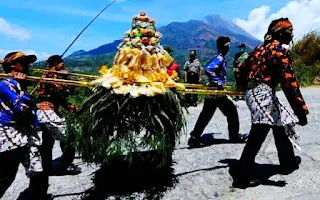

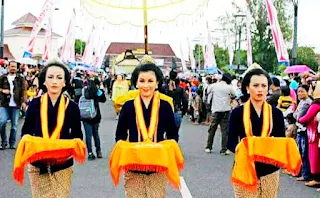

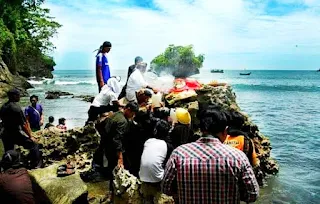





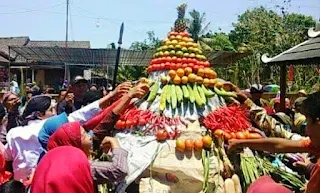


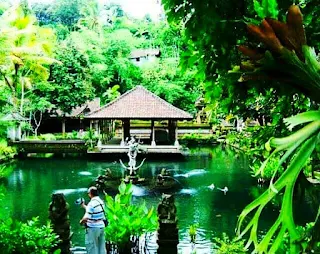
Post a Comment for "Sedekah Bumi Tradisi unik di Indonesia yang masih di lestarikan"